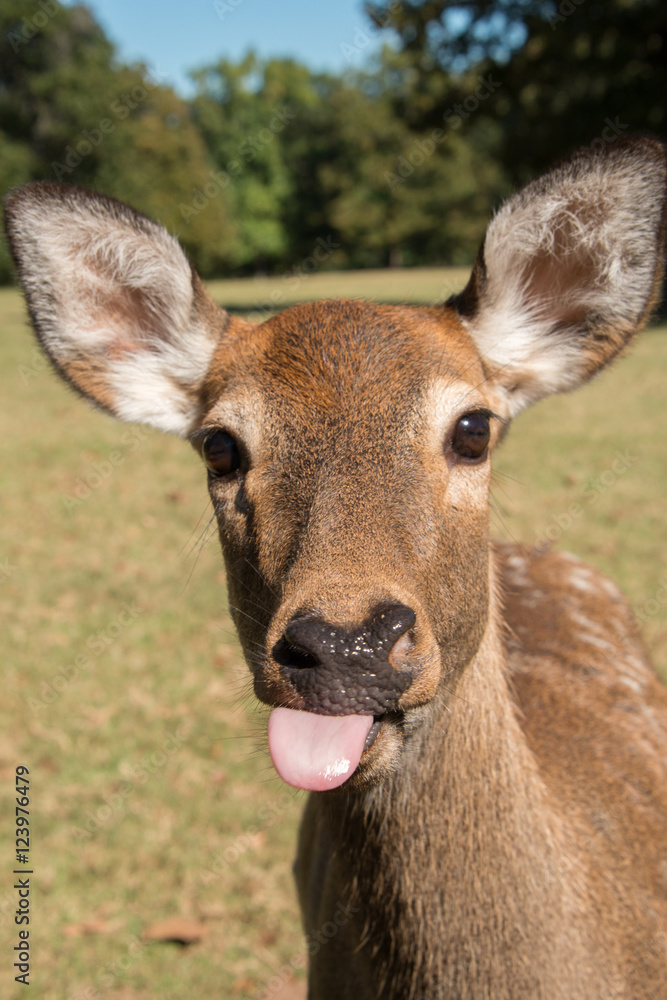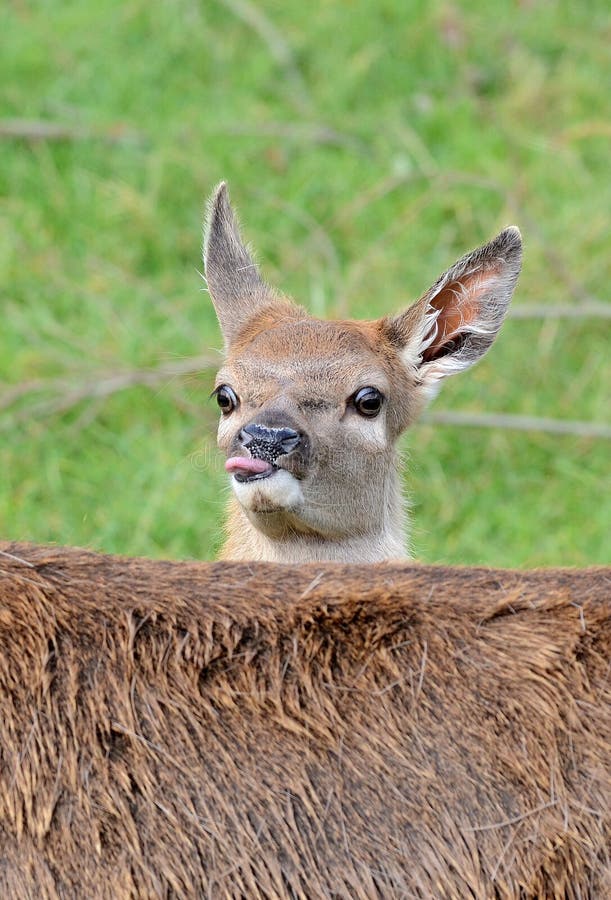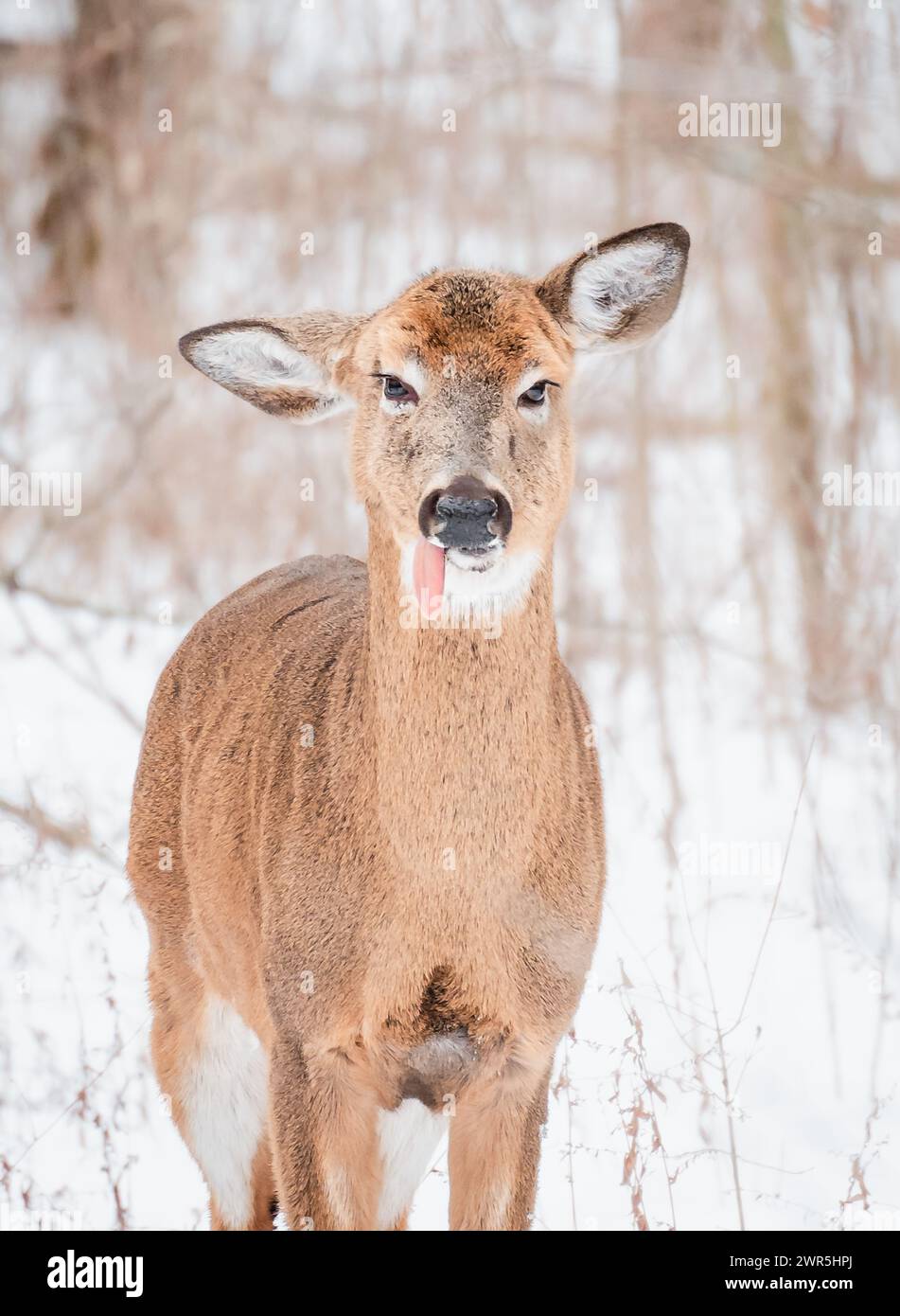Have you ever seen a deer with its tongue hanging out? This sight can be both amusing and puzzling.
Deer often exhibit this behavior, which can be due to various reasons. Understanding why deer do this can help us learn more about their habits and health. Wild animals like deer have unique behaviors that can seem strange to us.
One such behavior is when a deer sticks its tongue out. This can happen for several reasons, from cooling down to showing signs of illness. Observing these signs can give us clues about a deer’s well-being. In this post, we will explore the possible reasons behind a deer’s tongue hanging out. This will help you understand more about these fascinating creatures and their behaviors in nature.
Deer Anatomy Basics
Understanding deer anatomy helps us learn more about these fascinating creatures. Their unique features and behaviors give them an edge in the wild. One aspect worth exploring is their tongue and mouth.
Tongue Structure
A deer’s tongue is long and flexible. It helps them grasp food easily. The tongue is rough, with small bumps called papillae. These help break down food and move it to the back of the mouth. The tongue also plays a role in grooming and cleaning their fur.
Mouth Functions
A deer’s mouth serves several important functions. It helps them eat, drink, and communicate. Their strong teeth and jaws are perfect for chewing tough plants. Deer have sharp incisors for cutting and flat molars for grinding. Saliva in their mouth aids digestion by breaking down food.
Normal Deer Behavior
Deer are fascinating creatures that exhibit a range of behaviors in the wild. Understanding their actions can offer insights into their daily lives. One common sight is seeing a deer’s tongue hanging out. This is often part of their normal activities and can be linked to various behaviors.
Feeding Habits
Deer have unique feeding habits that involve a lot of chewing and tasting. Their tongues play a crucial role in this. They use their tongues to grasp and manipulate food. This helps them eat leaves, twigs, and other vegetation.
| Food Type | Percentage of Diet |
|---|---|
| Leaves | 60% |
| Twigs | 20% |
| Fruits | 10% |
| Grass | 10% |
While they feed, their tongues may hang out occasionally. This helps them manage their food intake better. It’s a natural part of their eating process.
Communication Methods
Deer use various methods to communicate with each other. One of these methods involves body language. The position of their tongue can send signals to other deer. For example, a deer with its tongue out might be showing relaxation or comfort.
- Body Language: Includes tail flicks, ear positions, and tongue movements.
- Vocalizations: Grunts, bleats, and snorts are common.
- Scent Marking: Glands on their bodies leave scent trails.
Understanding these cues helps in studying their social interactions. Tongue movements are just one small part of their complex communication system.
Reasons For Tongue Hanging Out
Seeing a deer with its tongue hanging out can seem odd. There are various reasons why deer exhibit this behavior. Understanding these reasons can help us learn more about deer and their habits.
Thermoregulation
Deer use their tongue to help regulate their body temperature. This process is called thermoregulation. When it’s hot, deer may pant and let their tongue hang out. This helps cool their body by evaporating moisture from the tongue’s surface.
Health Issues
Health issues can also cause a deer’s tongue to hang out. Dental problems, infections, or injuries to the mouth can make it hard for deer to keep their tongue inside. They might also have nerve damage or other conditions affecting muscle control.

Credit: stock.adobe.com
Environmental Factors
Environmental factors play a crucial role in the behavior of deer. One common behavior observed is their tongue hanging out. This could be influenced by different external conditions. Understanding these factors can help us comprehend deer behavior better.
Weather Conditions
Weather conditions impact deer behavior significantly. During hot weather, deer may have their tongue hanging out. This helps them cool down. They do not sweat like humans. Instead, they regulate their body temperature by panting. This is why their tongue hangs out more in the heat.
Cold weather also affects deer. In the winter, deer need to conserve energy. They might stick out their tongue to sense their surroundings. It helps them detect predators. This behavior can seem curious but is essential for their survival.
Habitat Impact
The habitat where deer live affects their tongue behavior too. In dense forests, deer use their tongue to navigate. They touch leaves and plants to identify them. This helps them find food and avoid poisonous plants. Their tongue acts like a sensory tool.
In open fields, deer may hang their tongue out less. There are fewer obstacles. They rely more on their vision. But, if the field has tall grass, their tongue comes into play again. It helps them feel the environment.
Urban areas also impact deer behavior. In cities, deer face different challenges. Noise and human activities can stress them. Stress can cause them to pant, leading to their tongue hanging out. Understanding these factors is key to understanding deer behavior.
Health Concerns
When a deer’s tongue hangs out, it may signal various health concerns. Recognizing these signs early can help prevent more serious issues. This section addresses the primary health concerns associated with a deer’s tongue hanging out.
Dental Problems
Dental problems can cause a deer’s tongue to hang out. Issues like broken teeth, gum disease, or infections in the mouth are common culprits.
Broken teeth make it hard for the deer to chew its food. The deer may stick its tongue out to ease the pain. Similarly, gum disease affects the health of a deer’s mouth.
The table below outlines common dental problems and their symptoms:
| Dental Problem | Symptoms |
|---|---|
| Broken Teeth | Difficulty chewing, visible cracks |
| Gum Disease | Swollen gums, bleeding |
| Mouth Infections | Bad breath, swelling |
Infections
Infections can also cause a deer’s tongue to hang out. Bacterial or viral infections may lead to swelling or discomfort in the mouth.
Bacterial infections often result in sores or ulcers. These can make it hard for the deer to keep its tongue inside its mouth. Viral infections may cause similar issues, leading to inflammation.
Here are some signs of infections in a deer:
- Swollen tongue
- Pus or discharge in the mouth
- Refusal to eat
If you spot these signs, seek help from a wildlife expert. This can ensure the deer gets the care it needs.

Credit: www.dreamstime.com
Deer Social Interactions
Deer are social animals that live in groups called herds. Their interactions are complex and involve various behaviors. Understanding these behaviors can help us learn more about their social structure. Two main aspects of deer social interactions are grooming behavior and dominance display.
Grooming Behavior
Grooming is a significant part of deer social interactions. It helps strengthen bonds within the herd. Deer use their tongues to clean each other’s fur. This action removes parasites and dirt. It also helps in reducing stress among the group members. Grooming is more common between related individuals, like mothers and their fawns.
During grooming, a deer will often stick out its tongue. This helps in reaching different parts of the body. Grooming behavior shows care and trust within the herd. It is an essential activity for maintaining social harmony.
Dominance Display
Dominance display is another crucial aspect of deer social interactions. In a herd, there is a clear hierarchy. Dominant deer assert their position through various behaviors. One common display is the “tongue out” gesture. A dominant deer may stick out its tongue to show superiority. This signals to others that it holds a higher rank.
Such displays often occur during mating season. Males, in particular, use dominance displays to attract females. They also use these gestures to ward off rivals. Understanding these signals helps in comprehending the social dynamics of a herd.
Dominance displays ensure that there is order within the group. It reduces conflicts and helps in maintaining a stable social structure.
Human Impact
Deer are often seen with their tongues hanging out. This is due to various human activities. Let’s explore how urbanization and feeding wildlife affect this behavior.
Urbanization Effects
Urbanization leads to habitat loss. Deer lose their natural homes. They move closer to human areas. This increases stress and changes their behavior. A stressed deer may show signs like its tongue hanging out.
Noise pollution is another issue. Construction sounds and traffic disturb deer. They get anxious. Anxiety can cause them to pant. Panting makes their tongues hang out.
Deer also face more threats in urban areas. Cars and pets can scare them. Fear and quick movements force their tongues out as they breathe heavily.
Feeding Wildlife
People sometimes feed deer. This seems kind but it is harmful. Artificial food can upset their digestion. A sick deer might show signs like its tongue hanging out.
Feeding deer also changes their diet. Natural foods are best for them. Unnatural foods cause health issues. They might struggle to eat and keep their tongues out more often.
Feeding deer can make them dependent. They lose the skill to find food. This leads to malnutrition. A weak deer will show unusual behaviors, including their tongues hanging out.
| Human Activity | Effect on Deer |
|---|---|
| Urbanization | Increased stress and anxiety |
| Noise pollution | Disturbs and causes panting |
| Feeding | Health issues and dependency |
Understanding these impacts helps us protect deer. We can reduce their stress and ensure their health. Let’s be mindful of our actions and their effects on wildlife.

Credit: www.alamy.com
Conservation Efforts
Deer tongue hanging out is a concern for wildlife conservationists. These majestic creatures face various threats. Conservation efforts are crucial to ensure their survival. Below are the strategies and actions taken to protect and raise awareness about deer populations.
Protection Strategies
Effective protection strategies are essential for deer conservation. Establishing protected areas is a key step. These areas provide safe habitats. They reduce the risk of poaching and habitat destruction. Implementing anti-poaching laws is also important. These laws deter illegal hunting. They ensure deer populations can thrive.
Another strategy is habitat restoration. This involves replanting native vegetation. It also includes creating corridors for deer to migrate safely. Monitoring deer populations helps track their health. This data informs future conservation actions. Collaboration with local communities is vital. It ensures sustainable practices are followed.
Public Awareness
Raising public awareness is crucial for deer conservation. Educating the community helps people understand the importance of protecting deer. Schools and community centers can host workshops. These workshops teach about deer and their role in the ecosystem. Media campaigns also play a significant role. They reach a wider audience. Social media, TV, and radio can spread the message effectively.
Encouraging responsible tourism is another method. Tourists should learn how to observe deer without disturbing them. Informational brochures can be distributed at parks and reserves. These brochures provide guidelines for respectful wildlife viewing. Volunteers and wildlife enthusiasts can also join awareness programs. Their efforts can amplify the conservation message.
Frequently Asked Questions
Why Is My Deer’s Tongue Hanging Out?
A deer’s tongue may hang out due to cooling down or injury. Observe for other symptoms.
Is It Normal For A Deer To Have Its Tongue Out?
Yes, it can be normal. Deer often cool down by sticking their tongues out.
Should I Be Worried If A Deer’s Tongue Hangs Out?
Concern is necessary if there are signs of distress or injury. Monitor closely.
Can Dehydration Cause A Deer’s Tongue To Hang Out?
Yes, dehydration can cause this. Ensure the deer has access to water.
How Can I Help A Deer With Its Tongue Out?
Provide water and observe for injuries. Contact wildlife experts if needed.
Conclusion
Understanding why a deer’s tongue hangs out can be fascinating. It may seem odd, but it’s often normal. Observing deer behavior gives insight into their health. Always pay attention to other signs. Deer are remarkable creatures. Their actions tell us a lot.
Next time you see a deer, notice its tongue. You might learn something new. Keep exploring nature’s wonders. There’s always more to discover.